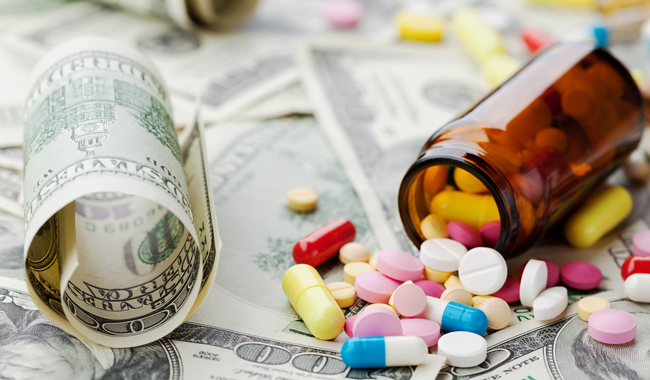
Prescription drugs have long been one of the greatest plagues on the country’s healthcare costs. While this issue has garnered attention for decades, the drug debate has a renewed vigor in Washington since President Trump unveiled his “Blueprint to Lower Drug Prices” last week. It’s too early to tell what effect the blueprint will have, but Trump’s message is clear: “One of my greatest priorities is to reduce the price of prescription drugs.”
Given the administration’s direction, the drug debate is shaping up to be a major focus for 2018. We’re already seeing new cost-containment efforts from major players in the healthcare industry. Earlier this year, multiple insurers (first UnitedHealthcare, then Aetna) made headlines with announcements of new direct-to-consumer pharmaceutical discount programs that would pass savings from drug manufacturers to patients. While insurers’ longstanding claim has been that money saved through drug discounts and rebates is indirectly passed to patients in the form of lower premiums, this new type of program goes a step further by directly reducing patient spending at the pharmacy counter.
What do you need to know about these new discount programs? Furthermore, what impact, if any, will they have on improving the cost of care associated with medical specialties that heavily depend on the use of drugs, such as oncology? We will explore these questions and more in this post.
What Happens with Drug Discounts Today?
The flow of money through today’s pharmaceutical supply chain is complex, to say the least. Pharmacy benefit managers (PBMs) serve as third-party administrators of prescription drug coverage for insurers and employers. Then, PBMs negotiate discounts with drug makers, which take the form of rebates paid directly to insurers or back to the PBM. These savings can substantially reduce the price insurers and PBMs pay for prescription drugs, often reducing the list price by 30% to 55%.
Despite these negotiations, insurers typically use the nondiscounted list prices to determine how much to charge patients who have deductibles and coinsurance. In some instances, this results in patients paying more for the drug than the insurer or PBM paid to acquire it—and yet the profit falls directly to those parties.
What Do These Discount Programs Mean for Consumers?
The new direct-to-consumer discount programs are scheduled to begin in 2019 and will focus on the fully insured commercial population. The number of benefit plan members who are eligible for pharmaceutical discounts under these programs is significant—initial estimates are that 7 million and 3 million eligible members for United and Aetna, respectively, will be affected. Insurers explain that the out-of-pocket (OOP) savings for a patient’s given prescription could range from a few dollars to over a thousand, but that overall, they anticipate passing millions of dollars of savings on to patients.
It’s important to point out, however, that insurers do not receive savings from negotiated discounts for all drugs. What this means for consumers is that while they may pay less OOP for some drugs under this program, payment for others may be unaffected. Overall, the greatest savings will likely be realized by two groups:
- Patients with high deductibles or coinsurance for prescription medicines. These patients have high spending thresholds, which means higher OOP payments.
- Patients who take prescription medicines for certain diseases, such as hepatitis C, multiple sclerosis, and rheumatoid arthritis. Pharmaceutical discounts tend to be popular in these therapeutic categories, where (1) drugs are priced high given their specialized nature and (2) there are multiple brand name options to choose from. The latter particularly incentivizes drugmakers to strike deals with insurers/PBMs to get their drug to be favored over a competitor’s.
What Is Motivating This Change?
The drug industry is prime for disruption, and there are several factors driving insurers’ decisions to launch such programs:
- The growing popularity of deductibles and coinsurance in commercial plans and resulting patient cost burden
- The rise in drug discounts (from $39 billion in 2008 to $125 billion in 2015) and consequential harsh spotlight cast on PBMs as middlemen reaping profits
- The Trump administration’s focus on cost control and a general call within the healthcare industry for pricing transparency
- Intensifying pressure from consumers
- Potential disruption of the pharmaceutical supply chain through unprecedented M&A deals and the entrance of nontraditional players into healthcare
What Can We Expect Next?
In thinking about potential implications of this type of program, there may be more questions than answers:
- Will other insurers follow suit with new direct-to-consumer discount offerings?
- Will the Trump administration enact transparency mandates for Medicare beneficiaries?
- Could premiums go up because insurers have a reduced pool of savings?
- Will pharmaceutical companies and PBMs respond with transparency initiatives of their own?
One thing is for sure: New or expanded insurer-PBM partnerships will force these parties to think differently about traditional prescription coverage and may fundamentally change drug contracting and pricing strategies moving forward.
The Cancer Angle
The cost of drugs is a particularly significant issue for oncology practices, as drugs make up more than 30% of a medical oncology physician’s total annual revenue.1 With the prices of anticancer drugs increasing at astounding rates—the average monthly cost of oncology drugs increased from $7,103 in 2006 to $15,535 in 2015—it is no surprise that this issue is reported as the number one challenge and concern for cancer programs in the United States.
Unfortunately, the impact of the drug discount programs being discussed here are unlikely to have an impact on cancer patients and practices. This is primarily because the new programs only apply to retail and self-administered drugs, the use of which is currently limited in the oncology space, as many patients have chemotherapy drugs administered in an infusion clinic.
While oral chemotherapy drugs are available for direct-to-consumer purchase through retail pharmacies, their rate of adoption has been slow and is likely to remain that way due to issues with patient compliance, among others. Even for the limited number of patients who can utilize oral therapies, two significant issues remain regarding these new discount programs:
- We don’t yet know the specifics of the United or Aetna programs in terms of which drugs will be eligible for discounts. Cancer drugs may not be included.
- Many cancer drugs face limited competition in the marketplace; this means drugmakers can demand higher prices, and discounts may not even exist in the first place.
A more significant overhaul of underlying drug pricing and purchasing methodologies will need to be enacted for the healthcare industry to see a major improvement in cancer drug prices.
Preparing for the Future
Depending on where you sit, these programs could represent a well-intended attempt to bring overdue transparency to the system and respond directly to growing consumer frustration over drug prices, or they could be considered a calculated maneuver to shift blame to pharmaceutical companies and play defense against new market entrants. Yes, these programs do a good deed in helping some consumers save money and are a step forward on the path to creating a more transparent pharmacy supply chain. However, they don’t address the underlying problems that drive the high drug prices that have such a detrimental effect on the healthcare system, particularly in the realm of cancer treatment.
Ultimately, significant evolution and change will need to occur in areas such as drug-pricing strategies, patent protection laws, and the structure and availability of prescription drug insurance coverage if we are to see the changes patients and providers are seeking. President Trump’s blueprint mentions several actions that could bring about such change—but the specifics remain to be seen. ECG will continue monitoring the Trump administration’s rollout of drug reform, so check back for future insights and analysis.
Footnotes
1. “The National Practice Benchmark for Oncology: 2015 Report for 2014 Data” (Journal of Oncology Practice, April 2016).

